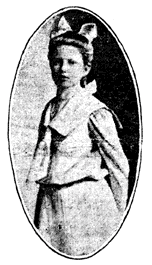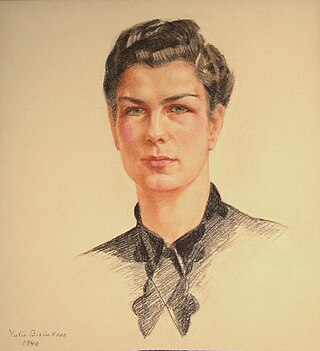
Sarah Hall is a stained glass artist from Canada. Sarah Hall is internationally recognized for her large-scale art glass installations and solar projects. Her work can be found in churches, synagogues, schools, and other commercial and public buildings in Canada, the US, and Europe.
Gazell Macy DuBois M. Arch, P. Eng, PP-FRAIC, PP-RCA, FAIA (hon) was an American-born Canadian architect who designed several landmark Toronto buildings.

Anna Wagner Keichline was an American architect, inventor, suffragist, and World War I Special Agent from Pennsylvania. She was the first woman to be registered as an architect in Pennsylvania and she was "one of the first women to actually practice architecture professionally". She was awarded seven patents, including one for a notched brick in 1927.
Siamak Hariri, OAA, AAA, AIBC, FRAIC, RCA, Intl. Assoc. AIA is a Canadian architect and a founding partner of Hariri Pontarini Architects, a full-service architectural and interior design practice based in Toronto, Canada.
Lily Inglis (1926-2010) was a Canadian architect born in Milan, Italy and received her education in England. She moved to Canada and joined the Ontario Association of Architects, becoming involved in the preservation of historic buildings in Kingston, Ontario. Inglis was also a member of Royal Institute of British Architects (1953) and Royal Architectural Institute of Canada (1985). She was a partner in Inglis and Downey Architects, Inc. She made a strong name for herself by proving to clients that even as a woman she was able to solve complex issues. This increased her creditability within the architectural field.

The Toronto Heliconian Club is a non-profit association of women involved in the arts and letters based in Toronto, Ontario. It operates out of Heliconian Hall, a historic building located in the Yorkville area of central Toronto. Founded in 1909, the Club still focuses on its original commitment to women supporting and working in the arts.
Marianne McKenna, OC, FRAIC, OAA, OAQ, AIA, RIBA is a Canadian architect and a founding partner of KPMB Architects, a Toronto-based practice established in 1987. She is an invested Officer of The Order of Canada "for her contributions as an architect, designing structures that enrich the public realm". Her projects include the renovation and expansion of The Royal Conservatory TELUS Centre for Performance and Learning and Koerner Hall. McKenna and KPMB were selected by The Brearley School, an independent all-girls school located in New York City, to lead the renovation of its building located on the Upper East Side. Her current projects also include for Banff Centre for Arts and Creativity in Banff, Alberta and an expansion and renovation of historic Massey Hall in Toronto In 2010 she was named one of Canada’s Top 100 Most Powerful Women and in 2014 she was named one of Toronto’s top 50 Powerful People by MacLean’s Magazine.
Helen Frances Gregor was a Czechoslovakian-Canadian artist who specialised in textile art.

Alexandra Biriukova was a Canadian architect and nurse. She is known for being the first woman in the Ontario Association of Architects and for her design of Lawren Harris's residence. She was the second woman to register as an architect in Canada.

Eleanore Kendall Pettersen was an American architect. She was one of the first licensed female architects in New Jersey, where she operated a private practice from 1952 to 2002.

Beverly Lorraine Greene, was an American architect. According to architectural editor Dreck Spurlock Wilson, she was "believed to have been the first African-American female licensed as an architect in the United States." She was registered as an architect in Illinois in 1942.

Rebecca L. Binder is an American architect, designer, and educator. She established R. L. Binder FAIA Architects, LLP, in 1979, in Playa del Rey, California. In 1990, Binder was named a Fellow of the American Institute of Architects. Her work has received significant recognition, including local, state and national awards. In 2001, the American Institute of Architects California Chapter presented Binder with the California "Firm of the Year" award.
Lennox Grafton was a Canadian architect and one of the first women to be trained as architects in Canada. She completed her undergraduate education in University of Alberta during 1938-1941 and graduated from the architectural program in University of Toronto in 1950. Grafton's early works during the same decade focused on schools, churches, and commercial building. These works were complete while she worked in several of Toronto architectural firms. In 1960 she started her own architectural practice, but had to eventually shutter it due to the lack of available funding to scale the business to acquire larger projects.
Henrietta May Steinmesch was an American architect most notable as a founding member and later the first national president of the Association of Women Architects.
The Association for Women in Architecture + Design is a nonprofit professional association based in Los Angeles, California. The organization aims to support women working in the fields of architecture and design through educational programming, networking, and mentoring. The history the association dates back to a Alpha Alpha Gamma, a collegiate organization established at Washington University in St. Louis.
Elsa Leviseur was a South African architect specializing in landscape and ecology. She practiced in South Africa and later in England and the US. She was born in Pretoria, South Africa in 1931. Her mother was Beryl Iris Basson (1897–1970) and her father was doctor Ernest Alfred Leviseur (1890–1976). She married conductor Ernest Fleischmann in 1953 at the age of 22. Motivated by her friends and her keen interest in forestry, she joined architecture and earned a B.Arch. degree at the University of Cape Town School of Architecture in 1954. She started a small office in South Africa and worked on designing hospitals, housing complexes and commercial projects.

Mary Evelyn Wrinch (1877–1969), was a Canadian artist who created miniature paintings, oil paintings, and block prints, sometimes inspired by the Northern Ontario landscape. She pioneered the 'Canadian style', painting landscapes with bold colours of the Algoma, Muskoka and Lake Superior regions, in situ. In her miniature paintings on ivory, she depicted her sitters with freshness and vitality. Her colour block prints are virtuoso examples of the medium.

Mary Imrie was a Canadian architect. She was one of the first women in Canada to establish an architectural firm. She is also considered to be Edmonton's first female architect.
Christina Poznanska Perks, OAA, FRAIC is a Canadian architect known for her contributions to the public sector by managing the design and construction of Canadian Embassies. Throughout her career she has been an advocate for women's rights in the architecture industry. In celebration of the first woman president of the OAA Perks responded with "...Ms. Kirkland has moved from the usual reported role of woman as victim to an active shaper of the future environment. Hurrah!" She currently resides in Toronto, Ontario.

A. Jane Duncombe was born in Whitby, Ontario, Canada. She was a residential designer based in the San Francisco Bay Area some of whose architectural designs can also be found in Illinois and the rest in California. Duncombe studied at the Art Institute of Chicago School of Industrial Design and developed interest in design and architecture through her undergraduate studies. Duncombe was also one of the few female architects who became an apprentice at Frank Lloyd Wright’s Taliesin.








